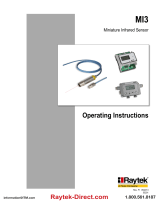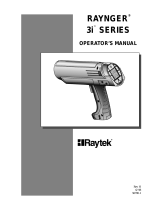
MI
Miniature Infrared Sensor
Operating Instructions
Rev. F 04/2006
54301

Declaratio nofConformityfortheEuropeanCommunit
y
Thisinstrumentconformsto:
EMC: IEC/EN61326‐1
Safety: EN61010‐1:1993/A2:1995

Contacts
Europe
RaytekGmbH
13127Berlin,Germany
BlankenburgerStr.135
Tel: +4930478008–0
+4930478008–400
Fax: +49304710251
USA
RaytekCorporation
CA95061–1820,SantaCruz
1201ShafferRd.POBox1820
Tel: +1831458–1110or
+1800227–8074
Fax: +1831458–1239
automation@raytek.com
UnitedKingdom
Tel: +441908630800
Fax: +441908630900
France
Tel: 0800888244
RaytekChinaCompany
Beijing,China
Tel: +861064392255
Fax: +861064370285
Internet:
http://www.raytek.com/
©RaytekCorporation.
Raytek,theRaytekLogo,andDataTempareregisteredtrademarksofRaytekCorporation.
Allrightsreserved.Specificationssubjecttochangewithoutnotice.

WARRANTY
Themanufacturerwarrantsthisinstrumenttobefreefromdefectsin
material and workmanship under normal use and service for the
period of two years from date of purchase. This warranty extends
onlytotheoriginalpurchaser.Thiswarrantyshallnotapplytofuses,
batteries, or any product that has been
subject to misuse, neglect,
accident,orabnormalconditionsofoperation.
In the event of failure of a product covered by this warranty, the
manufacturer will repair the instrumentwhen it is returned by the
purchaser, freight prepaid, to an authorized Service Facility within
the applicable warranty period, provided manufacturer’s
examination
discloses to its satisfaction that the product was
defective.Themanufacturermay,atitsoption,replacetheproductin
lieu of repair. With regardto any covered product returned within
theapplicablewarrantyperiod,repairsorreplacementwillbemade
without charge and with return freight paid by the manufacturer,
unless
the failure was caused by misuse, neglect, accident, or
abnormal conditions of operation or sto rage, in which case repairs
willbebilledatareasonablecost.Insucha case,anestimatewillbe
submittedbeforeworkisstarted,ifrequested.
THE FOREGOING WARRANTY IS IN LIEU OF ALL OTHER
WARRANTIES, EXPRESSED OR IMPLIED, INCLUDING BUT
NOT LIMITED TO ANY IMPLIED WARRANTY OF
MERCHANTABILITY, FITNESS, OR ADEQUACY FOR ANY
PARTICULAR PURPOSE OR USE. THE MANUFACTURER
SHALL NOT BE LIABLE FOR ANY SPE CIAL, INCIDENTAL OR
CONSEQUENTIAL DAMAGES, WHETHER IN CONTRACT,
TORT,OROTHERWISE.

TABLEOFCONTENTS
1SAFETYINSTRUCTIONS............................................1
2DESCRIPTION ...............................................................3
3TECHNICALDATA ......................................................4
3.1MEASUREMENTSPECIFICATIONS...............................4
3.2OPTICALSPECIFICATIONS ..........................................6
3.3ELECTRICALSPECIFICATIONS ....................................7
3.4ENVIRONMENTALSPECIFICATIONS ...........................8
3.5DIMENSIONS...............................................................9
3.6SCOPEOFDELIVERY .................................................10
4BASICS...........................................................................11
4.1MEASUREMENTOFINFRAREDTEMPERATURE.........11
4.2EMISSIVITYOFTARGETOBJECT................................12
4.3AMBIENTTEMPERATURE .........................................12
4.4ATMOSPHERICQUALITY ..........................................12
4.5ELECTRICALINTERFERENCE ....................................13
5INSTALLATION ..........................................................14
5.1POSITIONING ............................................................14
5.1.1DistancetoObject.............................................14
5.2WIRING.....................................................................15
5.2.1SensorHeadCable ............................................15
5.2.2CablePreparations............................................16
5.3OUTPUTS...................................................................18

5.3.1SignalOutput................................................... 19
5.3.2HeadAmbientTemp./AlarmOutput ............. 20
5.3.3ThermocoupleOutput.......................................22
5.4INPUTSFTC.............................................................. 23
5.4.1EmissivitySetting(analogcontrolled) ............. 24
5.4.2EmissivitySetting(digitalcontrolled) ............. 25
5.4.3AmbientBackgroundTemperature
Compensation ............................................................
26
5.4.4TriggerandHoldFunction............................... 28
5.5CONNECTINGTOTHEPCVIARS232 ...................... 30
5.6INSTALLINGOFMULTIPLES ENSORSVIARS485...... 31
6OPERATION................................................................. 34
6.1CONTROLPANEL ..................................................... 34
6.2SETTINGOFMODES.................................................. 35
6.3SETTINGTHEOUTPUTJUMPER ................................ 35
6.4POSTPROCESSING.................................................... 38
6.4.1Averaging ......................................................... 38
6.4.2PeakHold.......................................................... 40
6.4.3ValleyHold ....................................................... 41
6.4.4AdvancedPeakHold......................................... 42
6.4.5AdvancedValleyHold ...................................... 43
6.4.6AdvancedPeakHoldwithAveraging............... 43
6.4.7AdvancedValleyHoldwithAveraging............ 43
6.5FACTORYDEFAULTS ................................................ 44
7OPTIONS....................................................................... 45

8ACCESSORIES .............................................................46
8.1OVERVIEW ................................................................46
8.2ADJUSTABLEMOUNTINGBRACKET.........................48
8.3FIXEDMOUNTINGBRACKET ....................................49
8.4AIRPURGINGJACKET...............................................50
8.5AIRCOOLINGSYSTEM..............................................52
8.6RIGHTANGLEMIRROR ............................................57
8.7BOXLID ....................................................................58
8.8PROTECTIVEWINDOW .............................................59
9MAINTENANCE..........................................................60
9.1TROUBLESHOOTINGMINORPROBLEMS ..................60
9.2FAIL‐SAFEOPERATION ............................................61
9.3SENSINGHEADEXCHANGE .....................................63
10SOFTWARE.................................................................65
11PROGRAMMINGGUIDE .......................................66
11.1TRANSFERMODES..................................................67
11.2GENERALCOMMANDSTRUCTURE ........................68
11.3DEVICEINFORMATION...........................................69
11.4DEVICESETUP ........................................................70
11.4.1TemperatureCalculation ................................70
11.4.2EmissivitySettingandAlarmSetpoints .......70
11.4.3PostProcessing ...............................................72
11.5DYNAMICDATA.....................................................72
11.6DEVICECONTROL ..................................................73
11.6.1OutputfortheTargetTemperature................73

11.6.2AnalogOutput,Scaling ................................. 73
11.6.3AlarmOutput ................................................. 73
11.6.4Factorydefaultvalues..................................... 73
11.6.5LockMode....................................................... 74
11.6.6ModeSettingfortheDigitalInputFTC3....... 74
11.6.7ChangingtheSensingHeadCalibrationData74
11.6.8AmbientBackgroundTemperature
Compensation ............................................................
74
11.7MULTIPLEUNITS(MULTIDROPMODE,RS485) .... 76
11.8COMMANDSET ...................................................... 77
12APPENDIX...................................................................81
12.1DETERMINATIONOFEMISSIVITY ........................... 81
12.2TYPICALEMISSIVITYVALUES ................................ 83
INDEX ............................................................................... 87

SafetyInstructions
MI 1
1SafetyInstructions
This document contains important information, which should be
keptatalltimeswiththeinstrumentduringitsoperationallife.Other
usersofthis instrumentshouldbegiventheseinstructionswiththe
instrument. Eventual updates to this information must be added to
the original document. The instrument should only be operated by
trained personnel in accordance with these instructions and loca l
safetyregulations.
AcceptableOperation
This instrument is intended only for the measurement of
temperature.Theinstrument is appropriateforcontinuoususe. The
instrument operates reliably in demanding co nditions, such as in
high environmental temperatures, as long as the documented
technicalspecifications
forallinstrumentcomponentsareadheredto.
Compliancewiththeoperatinginstruc tionsisnecessarytoensurethe
expectedresults.
UnacceptableOperation
Theinstrumentshouldnotbeusedformedicaldiagnosis.
ReplacementPartsandAccessories
Use only original parts and accessories approved by the
manufacturer. The use of other products can compromise
the
operationalsafetyandfunctionalityoftheinstrument.
InstrumentDisposal
Disposal of old instruments should be handled according to
professionalandenvironmentalregulationsaselectronicwaste.

SafetyInstructions
2 MI
OperatingInstructions
The following symbols are used to highlight essential safety
informationintheoperationinstructions:
Helpful information regarding the optimal use of the
instrument.
Warnings concerning operation to avoid instrument
damage.
Warningsconcerningoperationtoavoidpersonalinjury.
Payparticularattentiontothefollowingsafetyinstructions.
Use in 110 /
230 VAC electrical systems can result in
electrical hazards and personal injury if not properly
protected.Allinstrumentpartssuppliedbyelectricitymust
becoveredtopreventphysicalcontactandotherhazardsat
alltimes.

Description
MI 3
2Description
The miniature infrared sensors MI are noncontact infrared
temperature measurementsystems.Theyaccuratelyandrepeatably
measure the amount of energy emitted from an object and convert
thatenergyintoatemperaturesignal.
Thefollowingoutputsareavailable:
• J‐Thermocouple
• K‐Thermocouple
• 0‐5Volt
• 0‐20mAor
4‐20mA
• 10mV/°Cheadambienttemperaturesignal
• RS232interface
• optional:RS485interface
ThesensingheadisprotectedbyaruggedIEC529(IP65,NEMA‐4)
stainlesssteelhousing,andisconnectedtotheelectronicboxwitha
1m (3ft) cable. Longer cables
must be ordere d as an option. The
electronic box is separated from the sensing head. This allows the
sensing head to be used in hot environments up to 180°C (356°F)
without cooling. The electronic box can only be used in ambient
temperaturesupto65°C(150°F).
MIwill allowsensing
heads tobe interchanged byprogramming in
the unique calibration data associated with different heads. Take
specialcareforthesensingheadcalibrationdataprintedonthecable!

TechnicalData
4 MI
3TechnicalData
3.1MeasurementSpecifications
TemperatureRange
LT‐40to600°C(‐40to1112°F)
forJ‐Thermocouple:‐25to600°C(‐13to1112°F)
SpectralResponse
LT 8to14μm
ResponseTime
Allmodels 150ms(95%response)
Accuracy
LT ±1%or±1°C(±2°F)whicheverisgreater
LT ±2°C(±
4°F)fortargettemp.<20°C(68°F)
TCoutputs ±1%or±2.5°C(±5°F)whicheverisgreater
Atambienttemperature23°C±5°C(73°F±9°F)
Repeatability
Allmodels ±0.5%or±0.5°C(±1°F)whicheverisgreater

TechnicalData
MI 5
TemperatureResolution
LT ±0.1K(±0.2°F)*
±0.25K(±0.5°F)**
*Forazoomedtemperaturespanof300°C(600°F)
**Forthefulltemperaturerangeoftheunit
TemperatureCoefficient
MIC ±0.05KperKor±0,05%/Kwhicheveris
greater,atambient:23
to125°C(73to185°F)
MIH ±0.05KperKor±0,05%/Kwhicheveris
greater,atambient:23to180°C(73to356°F)
MIC,MIH ±0.1KperKor±0.1%perKwhicheveris
greater,atambient:0to23°C(32to73°F)
MID
±0.15KperKor±0.15%perKwhicheveris
greater,atambient:0to85°C(32to185°F)
Box ±0.1KperKor±0.1%perKwhicheveris
greater
ThermalShock(within20min.)
LT ±3.5KatΔT
ambient=25K(45°F)
attargettemperatureof50°C(45°F)
Emissivity
Allmodels 0.100to1.100
Transmission
Allmodels 0.100to1.000

TechnicalData
6 MI
3.2OpticalSpecifications
OpticalResolutionD:S
MID,MIC;MIH 22:1(typ.),21:1(guaranteed)
MID,MIC;MIH 10:1
MID,MIC 2:1
At90%energyinminimumanddistance400mm(15.7in.)
Figure1:SpotSizeChart

TechnicalData
MI 7
3.3ElectricalSpecifications
PowerSupply
Voltage 12to26VDC
Current 100mA
Outputs
1.Output(OUT) 0to20mA,or
4to20mA,or
0to5V,or
Thermocouple(JorK)
2.Output(AMB)0to5Voutputforheadambienttemperature
(0to500°C,32to932°F)
oroutputforalarm
relay(softwareenabled,onlyinconjunction
withRS232/485)
mAOutput recommendedlo opimpedancesee
Figure9on
page
19.
0to5VOutputs min.loadimpedance100kΩ(alowerload
impedancedeterioratestheaccuracy)
outputimpedance100Ω
shortcircuitresistant
Thermocouple outputimpedance20Ω
shortcircuitresistant

TechnicalData
8 MI
3.4EnvironmentalSpecifications
AmbientTemperature
MIHsensinghead 0to180°C(32to356°F)
MICsensinghead 0to125°C(32to257°F)
MIDsensinghead 0to85°C(32to185°F)
MIDwithaircooling‐18to200°C(0to392°F)
Electronicsbox 0to65°C(32to150°F)
StorageTemperature ‐10
to85°C(14to185°F)
Rating(Head) IP65(NEMA‐4),notformodelswithan
opticalresolutionof2:1
Rating(Box) IP65(NEMA‐4)
RelativeHumidity 10%to95%non‐condensing
EMC IEC61326‐1
max.cablelength3m(118in.)
Vibration(Head) IEC60068‐2‐6:2
G,10to150Hz,3axes
Shock(Head) IEC60068‐2‐27:50G,11ms,3axes
Weight(Head) 50g(2oz.)with1mcable,stainlesssteel
Weight(Box) 270g(10oz.),die‐castzinc
HeadCableMaterial
MID/MIC PUR(Polyurethane),Halogenfree,
Siliconefree
MIH Teflon
®
Teflon develops poisonous gasses when it comes into
contactwithflames!

TechnicalData
MI 9
3.5Dimensions
Figure2:DimensionsofSensingHead
Standard cable length
1 m (3 ft.)
MID/MIC: Ø 5 mm (0.2 in)
MIH: Ø 3 mm (0.12 in)
2 mounting holes,
Ø 4.5 mm
(
0.17 in
)

TechnicalData
10 MI
Figure3:DimensionsofElectronicBox
3.6ScopeofDelivery
Thescopeofdeliveryincludesthefollowing:
• Sensinghead
• 1mheadcable
• Mountingnut
• Electronicbox
• Operatinginstructions

Basics
MI 11
4Basics
4.1MeasurementofInfraredTemperature
All surfaces emit infrared radiation The intensity of this infrared
radiation changes according to the temperature of the object.
Depending on the material and surface properties, the emitted
radiationliesina wavelengthspectrumofapproximately1to20μm.
Theintensityoftheinfraredradiation(”heatradiation”)isdependent
on
the material. For many substances this material‐dependent
constant is known. This constant is referred to as the ”emissivity
value”.
Infrared thermometers are optical‐electronic sensors. These sensors
are sensitive to the emitted radiation. Infrared thermometers are
madeupofalens,aspectralfilter,asensor,andanelectronic
signal
processing unit. The task of the spectral filter is to select the
wavelength spectrum of interest. The sensor converts the infrared
radiation into an electrical signal. The signal processing electronics
analyze the electrical signals and co nvert it into a temperature
measurement. As the intensity of the emitted infrared radiation is
dependentonthematerial,therequiredemissivitycanbeselectedon
thesensor.
The biggest advantage of the infrared thermometer is its ability to
measure temperature withou t touching an object. Consequently,
surfacetemperaturesofmovingorhardtoreachobjectscaneasilybe
measured.

Basics
12 MI
4.2EmissivityofTargetObject
Todeterminetheemissivityof thetarget objectrefertosection12.1
Determination of Emissivity on page 81. If emissivity is low,
measured results could be falsified by interferinginfraredradiation
from background objects (such as heating systems, flames, fireclay
bricks, etc. close beside or behind the target object). This type of
problemcanoccurwhenmeasuringreflectivesurfacesandverythin
materialssuchasplastic
filmsandglass.
Thismeasurement error can be reduced to a minimum if particular
care is taken during installation, and the sensing head is shielded
fromthesereflectingradiationsources.
4.3AmbientTemperature
The sensing head was developed for the following ambient
temperatureranges:
• MIH:0to180°C(32to356°F)
• MIC: 0to125°C(32to257°F)
• MID:0to85°C(32to185°F)
The MID can operate in ambient temperatures up to 200°C (392°F)
withtheair‐coolingaccessory.
4.4AtmosphericQuality
If the lens gets dirty, infrared energy will be blocked and the
instrumentwillnotmeasureaccurately.Itisgoodpracticetoalways
keep the lens clean. The Air Purge Jacket helps keep contaminants
from building up on the lens. If you use air purging, make sure a
filtered air supply
with clean dry air at the correct air pressure is
installedbeforeproceedingwiththesensorinstallation.
Page is loading ...
Page is loading ...
Page is loading ...
Page is loading ...
Page is loading ...
Page is loading ...
Page is loading ...
Page is loading ...
Page is loading ...
Page is loading ...
Page is loading ...
Page is loading ...
Page is loading ...
Page is loading ...
Page is loading ...
Page is loading ...
Page is loading ...
Page is loading ...
Page is loading ...
Page is loading ...
Page is loading ...
Page is loading ...
Page is loading ...
Page is loading ...
Page is loading ...
Page is loading ...
Page is loading ...
Page is loading ...
Page is loading ...
Page is loading ...
Page is loading ...
Page is loading ...
Page is loading ...
Page is loading ...
Page is loading ...
Page is loading ...
Page is loading ...
Page is loading ...
Page is loading ...
Page is loading ...
Page is loading ...
Page is loading ...
Page is loading ...
Page is loading ...
Page is loading ...
Page is loading ...
Page is loading ...
Page is loading ...
Page is loading ...
Page is loading ...
Page is loading ...
Page is loading ...
Page is loading ...
Page is loading ...
Page is loading ...
Page is loading ...
Page is loading ...
Page is loading ...
Page is loading ...
Page is loading ...
Page is loading ...
Page is loading ...
Page is loading ...
Page is loading ...
Page is loading ...
Page is loading ...
Page is loading ...
Page is loading ...
Page is loading ...
Page is loading ...
Page is loading ...
Page is loading ...
Page is loading ...
Page is loading ...
Page is loading ...
/









